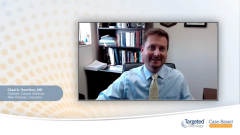
Ovarian Cancer: Strategies for Managing GI Toxicities and Fatigue from PARP Inhibitors
Chad A. Hamilton, MD, shares strategies for managing gastrointestinal toxicities and fatigue for patients receiving PARP inhibitors for the treatment of ovarian cancer.
Episodes in this series

Case: A 49-Year-Old Woman with BRCA-WT Ovarian Cancer
- A 49-year-old presented to her primary care physician complaining of abdominal bloating and nausea
- PMH: mild HTN
- FH: mother died of breast cancer at age 59; cousin on mother’s side died of ovarian cancer at age 65
- Imaging: CT reveals small-volume ascites, bilateral 8-cm adnexal masses
- Labs: CA 125, 285 U/mL
- Surgical intervention: she underwent exploratory laparotomy followed by omentectomy, bilateral salpingo-oophorectomy, and resection of peritoneal nodules; optimal cytoreduction with < 1 cm of residual disease after surgery
- Diagnosis: stage IIIC HGSC
- Treatment: She was treated with IV carboplatin and paclitaxel w/ NK1, 5HT3, and dexamethasone CINV prophylaxis
- TRAEs: She experienced persistent daily nausea with vomiting on day 1 after chemotherapy
- Follow-up: After completion of chemotherapy, CA 125, 14.2; clinically NED; patient reports continuing daily nausea
Transcript:
Chad A. Hamilton, MD: Some of the toxicities that I find to be most challenging are ones that occur very commonly, the GI [gastrointestinal] toxicities and patients struggling with fatigue. I think the reason I find them challenging is because there’s a lot of overlap with other things that could be causing those symptoms. It could be residual from their prior chemotherapy; it could be the stress of having cancer. It could be the disease process itself. It’s a little challenging to parse out what’s causing what.
For nausea, the NCCN [National Comprehensive Cancer Network] provides pretty informative guidelines to how to approach that, and it really highlights a multifactorial approach including pharmacologic treatments, dose modification, and dietary or lifestyle changes. The backbone of pharmacological treatments are the 5-HT3 antagonists like ondansetron or similar drugs with additional agents layered on top of that from a different drug class if needed. Dose holds and reductions may play an important role as well, and certainly lifestyle changes, looking for patterns that may stimulate the patient’s nausea, encouraging them to do things like smaller, more frequent meals. Certainly, complementary approaches have been helpful. We have a number of patients who are using acupuncture or meditation. We have an active Integrative Health Group that also works with our patients. They help us incorporate these complementary approaches as well.
Similar to the GI adverse effects or nausea, NCCN also offers guidelines or guidance relative to fatigue, something that is obviously multifactorial and difficult to manage. I think a lot of it is it’s just important to ask patients what they’re feeling and really [take] a moment to listen and hear their concerns. Educate them that fatigue is common, but it also often improves or at least plateaus with treatments, especially after the first 2 to 3 months. We like to discuss their fatigue level as well as their level of function, and that may be two very different things for patients. And then we consider of course dose holds and reductions and make every effort to rule out other potential causes of fatigue, things like anemia, insomnia, depression, that are so common in our patients as well. Lastly, I always encourage exercise and staying active to my patients. I think that helps out in multiple aspects, whether it’s fatigue, or if it’s chemotherapy-induced neuropathy or things like that.
What I think is the most effective way to address these in my practice is keeping in mind that these are multifactorial processes. Certainly, the PARP inhibitor or the maintenance therapy could be contributing to it, a small or large portion. And every patient is unique. I’m an old, retired Air Force colonel. And in the Air Force, and in particular pilots have a checklist for just about everything. They’re often strapped on the pilots’ thighs as they go to fly, and they address everything from safety checks before takeoff to in-flight emergencies to landing sequences. I use these published guidelines from either ASCO [American Society of Clinical Oncology] or NCCN like my checklists. I will bring that list into the patient’s room and check off the things that could be causing their nausea. [I look at whether] I have X, Y, and Z to try to rule out or treat some level of that. I also encourage my midlevels and nurses to do the same, to carry those guidelines in or at least a cheat sheet from those guidelines and make sure you’re addressing all aspects of potential causes and treatments for those concerns.
Transcript is AI-generated and edited for clarity and readability.








































